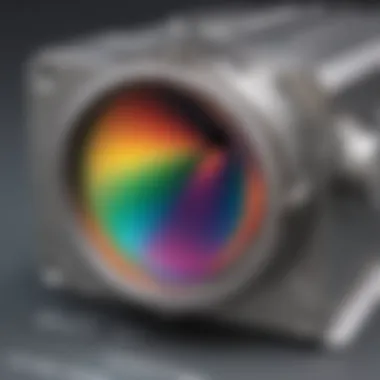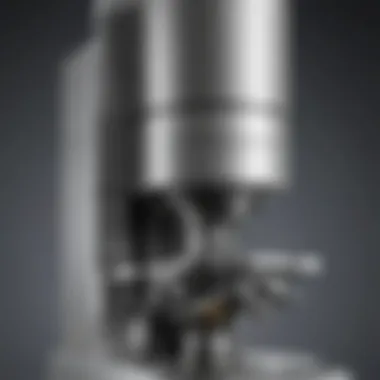Exploring Techniques for Identifying Metal Types: A Detailed Guide


Science Fun Facts
As we embark on the journey of metal identification, let us delve into some intriguing science facts to set the stage for our exploration. Did you know that metals make up a significant portion of the Earth's crust, playing a crucial role in various industrial processes and everyday objects? Understanding the properties of metals is essential for distinguishing between different types and harnessing their unique characteristics.
Discover the Wonders of Science
In this section, we will unravel the mysteries behind metal identification by delving into various scientific concepts. Through educational videos and animations, we will witness the intricate mechanisms that govern metal properties and behaviors. Exploring real-life applications of metal analysis in fields such as archaeology and engineering will highlight the practical significance of our endeavors.
Science Quiz Time
Engage your curious minds with interactive quizzes designed to test your knowledge of metal identification techniques. From multiple-choice questions challenging your understanding of metal composition to brain teasers that provoke critical thinking, this section aims to reinforce learning through gamification. Get ready to sharpen your skills and emerge as a metal identification expert!
Science Experiment Showcase
Get hands-on experience with fun and engaging experiments designed to deepen your understanding of metal characteristics. Follow step-by-step instructions carefully curated to help you conduct experiments safely and effectively. With a comprehensive materials list and crucial safety tips at your disposal, you'll embark on a scientific journey filled with discovery and learning.
Introduction to Metal Identification
Metal identification plays a crucial role in various industries where the composition of metals is of utmost importance. Understanding the different types of metals and their properties is essential for ensuring the quality of products and structures. In this comprehensive guide, we delve into the significance of metal identification, exploring how it influences decision-making processes and the overall efficiency of operations. By recognizing the unique characteristics of each metal, professionals can make informed choices that impact production, safety, and sustainability.
Understanding the Importance of Metal Identification
Metal Composition in Various Industries
Metal composition in various industries is a pivotal aspect that dictates the performance and applications of metals. Different industries require specific types of metals with distinct properties to meet their operational needs. For instance, the aerospace industry often favors lightweight, high-strength metals like aluminum and titanium for aircraft construction. Understanding the composition of metals used in different sectors enables precision engineering and tailored solutions, enhancing product quality and performance.
Safety Implications of Incorrect Metal Identification
Incorrect metal identification can have significant safety implications, ranging from structural failures to hazardous material handling. Using the wrong type of metal in a critical application can compromise the integrity of a system, leading to potential accidents or malfunctions. For example, using a non-corrosion-resistant metal in a chemical processing plant can result in material degradation and leakages, posing risks to workers and the environment. By emphasizing the importance of accurate metal identification, organizations can mitigate safety hazards and uphold industry standards.
Common Types of Metals
Ferrous Metals
Ferrous metals, such as iron and steel, are highly prevalent in construction, manufacturing, and infrastructure projects due to their robustness and magnetic properties. Their magnetic characteristics make them ideal for applications like electromagnetic shielding and structural frameworks where stability is paramount. Despite their susceptibility to corrosion, ferrous metals remain a popular choice for a wide range of industrial applications, thanks to their strength and durability.
Non-Ferrous Metals


Non-ferrous metals, including aluminum, copper, and zinc, offer excellent corrosion resistance and electrical conductivity, making them valuable in electrical and architectural industries. Aluminum, known for its lightweight nature and malleability, is widely used in aerospace and automotive applications. Non-ferrous metals play a vital role in modern technologies and sustainable practices, contributing to resource efficiency and environmental conservation.
Precious Metals
Precious metals like gold, silver, and platinum hold unique qualities that make them highly sought after in jewelry, electronics, and monetary systems. Their rarity, malleability, and conductivity properties distinguish them from other metals, imparting a sense of luxury and value to products. While precious metals command premium prices, their use extends beyond ornamental purposes to include critical roles in technical manufacturing and industrial processes, solidifying their significance in diverse sectors.
Visual Inspection Techniques
Visual Inspection Techniques play a crucial role in the process of identifying metals accurately. By visually examining the physical characteristics of a metal sample, experts can gather valuable insights that aid in determining its composition and properties. This method is particularly essential in situations where quick assessments are needed or when other testing methods may not be feasible. Visual Inspection Techniques encompass a range of observations, including evaluating the color and luster, surface texture, and the presence of coatings on the metal surface.
Macroscopic Examination
Color and Luster
In the domain of metal identification, Color and Luster serve as fundamental indicators that provide initial clues about the type of metal under consideration. Color refers to the specific hue exhibited by the metal, which can vary widely across different metal types. Luster, on the other hand, denotes the way light interacts with the metal surface, indicating characteristics like reflectivity and shininess. Understanding Color and Luster aids in distinguishing between various metal categories and is a cornerstone in the preliminary assessment of metal samples. Although subject to variations based on lighting conditions and surface finish, Color and Luster observations offer valuable information essential for accurate metal identification.
Surface Texture
The Surface Texture of a metal sample plays a pivotal role in visual inspections as it provides insights into the manufacturing processes and potential applications of the metal. Texture refers to the physical feel of the metal surface and may range from smooth and polished to rough and textured. By analyzing the Surface Texture, experts can discern important details such as the presence of machining marks, signs of corrosion, or surface treatments applied to the metal. Understanding Surface Texture is crucial in determining the condition and history of the metal, offering valuable clues that aid in accurate identification and characterization.
Presence of Coatings
The Presence of Coatings on a metal surface can significantly influence its appearance and properties, affecting how the metal interacts with its environment and other substances. Coatings may include layers of paint, plating, or protective finishes that alter the surface's color, texture, or conductivity. Detecting the Presence of Coatings is essential during visual inspections as it helps in differentiating between the base metal and any applied surface treatments. Analyzing the type and condition of coatings provides valuable information about the metal's history, corrosion resistance, and potential uses, contributing to a comprehensive understanding of the metal sample. Being mindful of the Presence of Coatings during visual inspections enhances the accuracy of metal identification and ensures the integrity of subsequent analyses.
Microscopic Analysis
Microscopic Analysis delves into the internal structure of a metal sample, offering detailed insights that complement visual observations and contribute to a comprehensive metal identification process. This method involves examining the grain structure along with the presence of inclusions and impurities within the metal matrix. By scrutinizing these microscopic features, analysts can uncover hidden characteristics, defects, or alloying elements that are crucial in determining the metal's composition and properties.
Grain Structure
The Grain Structure of a metal refers to the arrangement of crystalline grains within the material, which is influenced by factors such as cooling rates and mechanical processing. Each metal type exhibits a distinct grain structure pattern, which can be observed under a microscope. Analyzing the Grain Structure provides information on grain size, orientation, and boundaries, offering insights into the metal's mechanical properties, thermal stability, and potential applications. Understanding the Grain Structure is essential in identifying metal alloys, detecting recrystallization, or assessing the impact of heat treatment, adding a layer of complexity and depth to the metal identification process.
Inclusions and Impurities
Inclusions and Impurities refer to foreign particles or non-metallic substances present within the metal matrix, affecting its properties and performance. Detecting and characterizing these inclusions is vital in evaluating the metal's purity, mechanical strength, and susceptibility to corrosion. Microscopic analysis of Inclusions and Impurities enables analysts to pinpoint material defects, identify segregation patterns, or assess the overall quality of the metal. By examining these microscopic elements, experts can make informed decisions regarding material selection, processing parameters, or quality control measures, ensuring the integrity and reliability of the identified metal.
Chemical Tests for Metal Identification


In the realm of metal identification, chemical tests play a pivotal role in unraveling the mysteries of metal composition. These tests offer a deep dive into the elemental makeup of metals, providing crucial insights for various industries. Drawing from the principles of chemistry, chemical tests enable the differentiation between different types of metals based on their unique reactions to specific substances. In this comprehensive guide on identifying metals, chemical tests serve as a fundamental pillar, aiding in the accurate determination of metal composition.
Acid Tests
Reaction with Dilute Acids
A fundamental aspect of metal identification through chemical tests is the reaction with dilute acids. This process involves observing the behavior of metals when exposed to specific acid solutions. The reaction with dilute acids serves as a significant indicator of the metal's composition, unveiling distinctive characteristics based on the resulting chemical reactions. The key advantage of utilizing this method lies in its simplicity and efficacy, allowing for a quick assessment of metal type based on observable reactions. Despite its straightforward nature, the reaction with dilute acids provides valuable insights into the identity of metals, making it a popular choice in the realm of metal identification.
Specific Acid Reactions for Different Metals
Delving deeper into chemical tests, specific acid reactions for different metals offer a tailored approach to metal identification. By understanding the unique reactions various metals exhibit when subjected to specific acids, analysts can determine the metal type with greater precision. Each metal reacts differently to distinct acid solutions, producing characteristic patterns that aid in accurate identification. The utilization of specific acid reactions enhances the diagnostic capabilities in metal identification, allowing for a finer distinction between metal types. While this approach offers detailed insights into metal composition, it requires meticulous observation and expertise to interpret the results effectively, balancing its advantages and complexities in the pursuit of accurate metal identification.
Flame Tests
Color Changes in Flame Test
Another intriguing method employed in chemical tests for metal identification is the utilization of flame tests to discern metal composition. This technique involves observing the unique colors produced when metals are introduced into a flame, unveiling distinct hues corresponding to different metals. The color changes in flame tests serve as a visual indicator of specific metal properties, aiding in the differentiation of metals based on their characteristic flame colors. The simplicity and immediacy of this method make it a valuable tool in rapid metal identification, providing initial clues regarding the metal's elemental composition.
Identifying Metals Based on Flame Color
Building upon the concept of flame tests, identifying metals based on flame color offers a systematic approach to differentiating between various metal types. By identifying the specific flame colors associated with different metals, analysts can categorize metals with accuracy, relying on the distinct hues emitted during the flame test. This method enhances the speed and efficiency of metal identification, offering a visual representation of metal properties through their unique flame colors. While this technique expedites the preliminary identification process, its efficacy is dependent on the observer's skill in discerning subtle color variations and linking them to specific metal compositions, blending art and science in the quest to decode metal mysteries.
Section IV: Instrumental Analysis Methods
In the realm of metal identification, instrumental analysis methods play a pivotal role. These techniques utilize advanced scientific instruments to delve deep into the properties of metals, offering a level of detail that is invaluable in accurate identification. From X-Ray Fluorescence (XRF) to Scanning Electron Microscopy (SEM), these methods provide a scientific backbone to the identification process.
Subsection: X-Ray Fluorescence (XRF)
Principles of XRF Analysis: X-Ray Fluorescence analysis entails bombarding a sample with X-rays, which causes the atoms to emit fluorescent X-rays. By measuring the energy and intensity of these X-rays, the elemental composition of the metal can be determined with precision. This non-destructive method allows for quick and reliable analysis of various metals, making it a preferred choice in many analytical laboratories and industrial settings.
Applications in Metal Identification: XRF finds extensive applications in metal identification due to its non-invasive nature and ability to analyze a wide range of elements simultaneously. It is particularly useful in determining the composition of alloys, verifying material compliance, and identifying contaminants. Its rapid analysis capabilities make it indispensable in industries where quick decisions based on material composition are crucial.
Subsection: Scanning Electron Microscopy (SEM)
Imaging and Elemental Analysis: SEM offers high-resolution imaging of metal surfaces, allowing for detailed elemental analysis and visualization of microstructures. It provides a closer look at the surface morphology and composition of metals, enabling the identification of defects, impurities, and phase analysis. SEM is essential in characterizing materials at the microscale, offering valuable insights for research and quality control.
High-Resolution Metal Identification: The high-resolution capabilities of SEM ensure intricate details of metal samples are captured, aiding in accurate identification and analysis. Its ability to provide compositional mapping and elemental analysis at the microlevel is instrumental in solving complex identification challenges. Despite its time-consuming nature, SEM's unmatched resolution makes it an indispensable tool for in-depth metal analysis and research.


Non-Destructive Testing Methods
In the realm of metal identification, Non-Destructive Testing Methods play a pivotal role. These methods offer a non-invasive approach to assessing the properties and quality of metals without causing any harm or alteration to the material. As we delve into this section, we will unravel the significance and implications of Non-Destructive Testing Methods in the broader spectrum of metal analysis.
Ultrasonic Testing
Evaluation of Internal Structure
Ultrasonic Testing is a revolutionary technique that involves evaluating the internal structure of metals by emitting high-frequency sound waves. This method enables us to inspect the integrity and homogeneity of metals without causing any disruption. The key aspect of Evaluation of Internal Structure lies in its ability to penetrate deep into the material, revealing any hidden flaws or inconsistencies. In the context of this article, the non-invasive nature of this technique makes it a compelling choice for accurately identifying metal properties. The unique feature of Evaluation of Internal Structure lies in its meticulous detection capabilities, allowing for a thorough assessment of a metal's inner composition. While its advantages include precise defect identification, one must also consider its limitations in detecting surface anomalies effectively.
Detection of Defects without Damage
The second facet of Ultrasonic Testing encompasses the Detection of Defects without Damage. By utilizing sound waves to investigate and locate potential defects in metals, this method ensures comprehensive analysis without compromising the metal's integrity. One of the standout features of Detecting Defects without Damage is its ability to pinpoint flaws at an early stage, facilitating timely corrective measures. In the context of this article, this approach emerges as a popular choice for its ability to maintain metal quality while identifying imperfections. The exceptional feature of Detection of Defects without Damage is its non-destructive nature, allowing for thorough inspections without causing harm to the material. Although its advantages include accurate defect detection, considerations must be made for its potential limitations in detecting certain types of defects.
Eddy Current Testing
Eddy Current Generation
Eddy Current Testing involves the generation of induced electrical currents to assess the conductivity and integrity of metals. This method offers a rapid and effective means of evaluating metal properties without physical contact. The key characteristic of Eddy Current Generation lies in its ability to detect surface flaws and inconsistencies with precision. In the context of this article, the non-intrusive aspect of this technique makes it highly beneficial for swiftly analyzing metal samples. The unique feature of Eddy Current Generation is its real-time feedback mechanism, ensuring immediate results for enhanced decision-making. While its advantages include quick defect identification, it is crucial to acknowledge the limitations related to the depth of inspection achievable with this method.
Applications in Metal Analysis
Exploring the Applications in Metal Analysis within Eddy Current Testing sheds light on its contribution to comprehensive metal identification. By utilizing induced currents to create electromagnetic fields, this approach enables swift and accurate analysis of a metal's properties. The key characteristic of Applications in Metal Analysis is its versatility in examining various metal alloys and compositions with efficiency. In the context of this article, this method stands out as a popular choice for its reliability and speed in metal assessment. The unique feature of Applications in Metal Analysis lies in its ability to differentiate between different metal types based on their electrical conductivity, offering valuable insights into material composition. While its advantages include rapid analysis, considerations should be given to its limitations in assessing non-conductive materials effectively.
Summary of Metal Identification Techniques
Integration of Visual, Chemical, and Instrumental Methods
The integration of visual, chemical, and instrumental methods represents a pivotal aspect of metal identification, synonymous with the convergence of artistry and precision in the domain of material analysis. By intertwining the perceptual acuity of visual inspection, the nuanced reactivity of chemical tests, and the exactitude of instrumental analyses, this approach offers a comprehensive and multi-faceted means of discerning metallic compositions.
A defining characteristic of this integration lies in its holistic nature, which enables users to triangulate information obtained from different methodologies, thereby corroborating the accuracy and reliability of the final identification. This synergistic blend of techniques not only enhances the detection capabilities but also provides a layer of validation that is indispensable in the field of metal analysis.
Moreover, the integration of visual, chemical, and instrumental methods stands out for its versatility and adaptability to diverse scenarios. Whether identifying alloys in a manufacturing setting or tracing the origins of archaeological artifacts, this amalgamation of methods offers a scalable and efficient solution for discerning the constituents of metals accurately.
While the integration of these techniques yields a potent arsenal for metal identification, it is essential to acknowledge certain drawbacks, such as the time and expertise required to proficiently employ each method. However, the cumulative benefits of enhanced accuracy, thoroughness, and reliability outweigh these challenges, making the integration of visual, chemical, and instrumental methods a preeminent choice for practitioners seeking in-depth and dependable results.
Importance of Accurate Metal Identification
The importance of accurate metal identification reverberates throughout the entire spectrum of industrial, scientific, and commercial endeavors, casting a long shadow of influence on the reliability and safety of diverse applications. At its core, accurate metal identification is the linchpin that underpins material integrity, regulatory compliance, and operational efficiency. Without precision in identifying metals, the repercussions can range from structural failures in engineering projects to contamination in food processing.
A fundamental characteristic that sets accurate metal identification apart is its role in fostering trust and credibility within the realms of quality assurance and regulatory adherence. By ensuring that the right metal is used for the right purpose, practitioners mitigate risks associated with material mismatch, corrosion, or mechanical failures, safeguarding both assets and individuals.
Furthermore, accurate metal identification serves as a gateway to innovation and optimization in material science and engineering. By precisely determining the composition of metals, researchers and engineers can unlock new possibilities for alloy design, performance enhancement, and sustainability initiatives. This aspect underscores the transformative power of accurate metal identification in driving progress and pushing the boundaries of metallurgical knowledge.
While the significance of accurate metal identification is indisputable, it is imperative to acknowledge the challenges related to training, equipment costs, and interpretation complexities that accompany this endeavor. Despite these hurdles, the benefits of enhanced reliability, compliance, and performance far outweigh the investments required, establishing accurate metal identification as a cornerstone of excellence in the realm of materials analysis.







